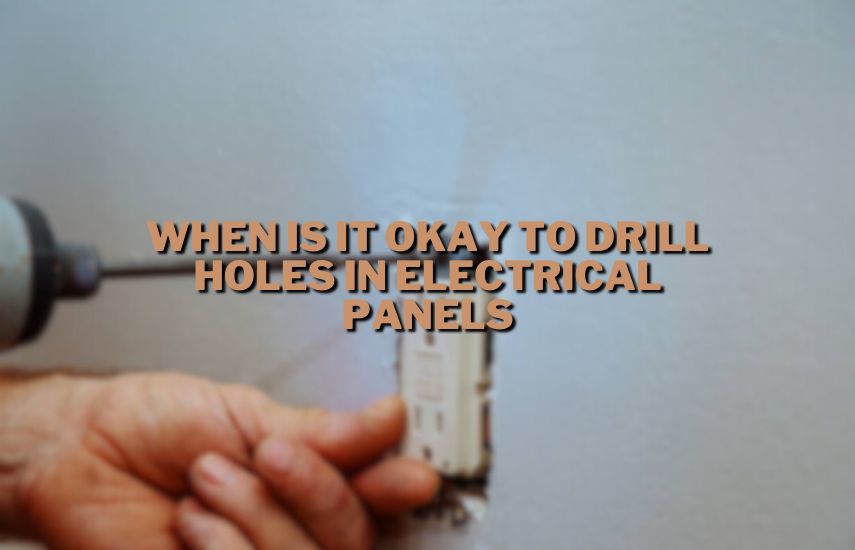Hello there! Have you ever wondered whether it’s okay to drill a hole in an electrical panel? Well, let’s talk about that.
An electrical panel, often referred to as a breaker box, is an important component of your home’s electrical system. It’s where all the electrical circuits in your house are connected and controlled.
Can You Drill Hole In Electrical Panel? It’s generally unsafe to drill holes in an electrical panel unless you’re a qualified electrician aware of specifications and local codes.
To prevent hazards and ensure compliance, seek professional assistance. Safety first to avoid risks like electrical fires or accidents.
While it might seem like a simple task to drill a hole in the panel for various purposes, such as mounting something or passing wires, it’s essential to approach this with caution.
Making holes in the wrong places can disrupt the wiring, potentially leading to safety hazards or even electrical malfunctions.
So, before you grab your tools, let’s delve into some key points to consider when it comes to drilling holes in an electrical panel.
The Safe and Proper Way to Drill Holes in Electrical Panels
Electrical panels are the nerve center of any building’s electrical system, ensuring power distribution to various circuits. The need to drill holes in electrical panels can arise for adding circuits, conduits, or other upgrades.
Such tasks demand careful consideration and adherence to safety protocols to prevent hazards and maintain the panel’s functionality. Here’s a guide on the safe and proper way to drill holes in electrical panels.
Prioritize Safety Precautions
Safety is paramount when working with electrical systems. Before drilling, switch off the power supply to the panel to eliminate the risk of electrical shock.
Wearing appropriate safety gear like gloves, safety glasses, and suitable clothing is essential to protect against debris and potential hazards.
Assess the Necessity
Determine whether drilling into the panel is necessary. Consider factors like the purpose of the hole and whether it adheres to local electrical codes and regulations. Consulting a licensed electrician or an expert can provide valuable insights into whether the drilling is warranted and safe.
Identify Wiring Paths
Understanding the existing wiring paths within the panel to avoid damaging wires or components. If available, refer to the panel’s schematic diagram to identify wire routes. Accidental damage to wires can lead to malfunctions or safety hazards.
Choose the Right Location
Selecting the appropriate drilling location within the panel is essential. Look for knockouts or blank areas provided for this purpose by the panel manufacturer. Avoid drilling near existing wires, components, or vital circuitry. Proper planning minimizes the risk of damaging critical elements.
Use Suitable Tools
Equipping yourself with the right tools is key for a successful and safe drilling process. High-quality metal drill bits designed for electrical panels are a must. Opt for a corded or cordless drill with adjustable speed settings to ensure precise control during drilling. Using a center punch before drilling can prevent drill bit slippage.
Employ a Careful Drilling Technique
Exercise caution and patience during the drilling process. Drill at a slow and steady pace, applying moderate pressure. Avoid drilling too deep, as this could potentially damage internal components and compromise the panel’s functionality.
Thorough Post-Drilling Inspection
After drilling the hole, thoroughly inspect the panel to ensure wires, components, or insulation have not been compromised. If any damage is detected, consult a professional electrician before proceeding further.
Seek Professional Assistance
When in doubt or facing a complex drilling scenario, seeking the expertise of a licensed electrician is a wise decision. Professional assistance ensures that modifications are done safely, adhering to regulations and minimizing risks.
When Is It Okay to Drill Holes in Electrical Panels

Electrical panels serve as the central hub for electricity distribution in buildings, making any modifications a task that requires careful consideration and adherence to safety guidelines. Drilling holes in electrical panels can be necessary for various reasons, but understanding when it is appropriate to do.
So to prevent hazards and ensure the panel’s functionality. Here’s a comprehensive guide to help you determine when it’s okay to drill holes in electrical panels.
Understanding the Purpose of Drilling
Before embarking on any modification, it’s essential to identify the purpose of drilling holes in the electrical panel. Common reasons include adding new circuits, installing conduits, or upgrading the panel itself. Ensure that the modification aligns with the building’s electrical requirements and codes.
Compliance with Electrical Codes and Regulations
Electrical work is subject to strict codes and regulations to ensure safety and prevent potential risks. Before drilling, it’s vital to consult local electrical codes and regulations to determine whether the planned modification is permitted. Compliance with these guidelines is paramount to guarantee a safe and legal modification.
Seeking Expert Advice
When in doubt about the necessity of drilling into an electrical panel, seeking advice from a licensed electrician or a professional who specializes in electrical systems is highly recommended. Experts can provide insights into whether the drilling is warranted, safe, and aligned with the building’s electrical needs.
Assessing Potential Risks
Assessing the potential risks associated with drilling into an electrical panel is essential. Consider factors such as the proximity of existing wires, the impact on the panel’s integrity, and the possible effects on the overall electrical system. A thorough risk assessment can help you make an informed decision.
Avoiding Unnecessary Modifications
Not every situation requires drilling into an electrical panel. If there are alternative methods to achieve the desired outcome without drilling, consider those options first. Minimizing modifications helps maintain the panel’s integrity and reduces potential risks.
Upgrading for Future Needs
Drilling holes in electrical panels can be justified when it’s part of a well-thought-out plan to upgrade the panel for future electrical requirements. As buildings evolve and electrical demands change, upgrading the panel to accommodate these changes can be a valid reason to drill holes.
Expansion of Electrical System
Expanding the electrical system to accommodate new appliances, circuits, or technologies can necessitate drilling holes for additional wiring or conduits. As long as this expansion aligns with the building’s electrical capacity and adheres to regulations, it’s a legitimate reason for modification.
Adding Safety Features
In some cases, drilling holes may be necessary to add safety features to the electrical panel, such as ventilation or cooling mechanisms. Prioritize safety enhancements to prevent overheating and ensure the panel’s longevity.
How to Drill Holes in Electrical Panels Without Damaging the Wires
Drilling holes in electrical panels is a delicate task that requires precision and careful execution to avoid damaging wires and compromising the integrity of the panel. Whether you’re an experienced electrician or a DIY enthusiast. Here’s a comprehensive guide on how to drill holes in electrical panels without damaging the wires.
Turn Off Power Supply and Wear Safety Gear
Before starting any work, turn off the power supply to the electrical panel to eliminate the risk of electrical shock. Additionally, wearing appropriate safety gear such as gloves and safety glasses to protect yourself from debris and potential hazards.
Identify Wiring Paths
Understanding the existing wiring paths within the electrical panel to avoid drilling through wires. Carefully examine the panel’s schematic diagram or visually trace the paths of the wires. This step helps you identify safe areas for drilling.
Choose the Right Location
Selecting the right location for drilling is key to preventing damage to wires and components. Choose blank areas or designated knockouts on the panel where drilling won’t interfere with existing wiring. Planning the location in advance reduces the risk of accidental damage.
Use the Correct Drill Bit
Selecting an appropriate drill bit is essential for drilling into the panel without causing damage. Choose a high-quality metal drill bit designed for use with electrical panels. Cobalt or titanium drill bits are known for their durability and ability to cut through metal cleanly.
Create a Pilot Hole
Before drilling the actual hole, use a center punch to create a small indentation at the desired drilling location. This prevents the drill bit from slipping and ensures a precise starting point.
Drill Slowly and Steadily
When drilling, use a slow and steady pace while applying moderate pressure. This prevents overheating of the drill bit and reduces the risk of damaging the panel or wires. Drilling too quickly can generate excess heat that could compromise the panel’s integrity.
Monitor Depth
Pay close attention to the depth while drilling. Avoid drilling too deeply, as this could damage internal components or wires. Most electrical panels have a metal cover or casing that serves as a protective layer, and drilling through it should be sufficient for most purposes.
Inspect After Drilling
After drilling the hole, thoroughly inspect the panel to ensure that no wires, insulation, or components have been compromised. Carefully look for any signs of damage or exposed wires. If any damage is detected, consult a professional electrician to assess the situation and make any necessary repairs.
Use Proper Cable Management
If you’re running new wires through the drilled hole, use proper cable management techniques to secure the wires and prevent them from coming into contact with sharp edges or abrasive surfaces. Cable clamps or conduit can help protect the wires and maintain a clean installation.
The Best Tools for Drilling Holes in Electrical Panels

Drilling holes in electrical panels requires not only precision but also the right tools to ensure a safe and successful outcome. The choice of tools significantly impacts the drilling process, helping you avoid damage to the panel and its components.
Whether you’re a professional electrician or a DIY enthusiast, selecting the best tools is crucial for a smooth drilling experience. Here’s a comprehensive guide to the essential tools for drilling holes in electrical panels.
Corded or Cordless Drill
A high-quality drill is the cornerstone of any drilling project. When choosing a drill for electrical panel work, opt for either a corded or cordless drill with adjustable speed settings. The adjustable speed provides better control, allowing you to drill at the appropriate pace.
Metal Drill Bits
Investing in quality metal drill bits designed for drilling through electrical panels is a must. Cobalt or titanium-coated drill bits are popular choices due to their durability and ability to handle metal surfaces effectively. Using the right drill bit prevents excessive heat buildup and ensures clean and precise holes.
Center Punch
A center punch is a small tool that creates an indentation at the desired drilling location. This indentation acts as a guide for the drill bit, preventing it from slipping off the surface while you start drilling. It’s a simple tool that can make a significant difference in accuracy.
Safety Gear
Ensuring your safety during the drilling process is paramount. Wear safety glasses to protect your eyes from debris and particles that may be generated while drilling. Additionally, using gloves and appropriate clothing safeguards your hands and body from potential hazards.
Voltage Detector
Before beginning any drilling work, it’s essential to confirm that the power supply to the electrical panel is turned off. A voltage detector helps you double-check that no live wires are present, providing an added layer of safety. This tool ensures you’re working in a de-energized environment.
Cable Management Tools
If your drilling involves running new wires through the holes, cable management tools come in handy. Cable clamps, grommets, and conduit are essential for securing and protecting the wires as they pass through the holes. Proper cable management minimizes wear and tear on the wires and prevents potential damage.
Step Drill Bit (Unibit)
For situations where you need to drill multiple sizes of holes, a step drill bit, also known as a unibit, is a versatile option. It can create different hole sizes with a single bit, eliminating the need to switch between multiple bits during the drilling process.
Magnetic Drill Press
In more complex drilling scenarios, such as when dealing with thick metal panels, a magnetic drill press can be a valuable tool. This tool securely attaches to the metal surface and provides precise drilling control, especially in situations where handheld drills might not be as effective.
Common Mistakes to Avoid When Drilling Holes in Electrical Panels
Drilling holes in electrical panels is a task that demands precision, caution, and adherence to safety guidelines. The consequences of mistakes can be severe, leading to compromised functionality, safety hazards, and costly repairs.
To ensure a successful drilling process and maintain the integrity of the electrical system, it’s crucial to be aware of common mistakes and how to avoid them. Here’s a comprehensive guide to the common mistakes to steer clear of when drilling holes in electrical panels.
Not Turning Off the Power
One of the most critical mistakes is failing to turn off the power supply before starting any drilling work. Live wires present a serious risk of electrical shock or even electrocution. Always double-check that the power supply is off and confirmed as de-energized before proceeding with any modifications.
Choosing the Wrong Location
Selecting an incorrect location for drilling is a common mistake that can lead to damaging wires, components, or vital circuitry within the electrical panel. Prior to drilling, study the panel’s layout and choose a blank area or designated knockout that won’t interfere with existing wiring or components.
Using Incorrect Drill Bits
Using the wrong type of drill bit for the panel’s material can lead to overheating, dulling of the bit, and potential damage to the panel. Invest in quality metal drill bits designed specifically for drilling through electrical panels. Cobalt or titanium-coated bits are recommended for their durability and precision.
Drilling Too Deep
Drilling too deep into the electrical panel poses a significant risk to the internal components and wiring. Damaging these elements can compromise the panel’s functionality and safety. To avoid this mistake, carefully control the depth of the drill and stop once you’ve penetrated the necessary layers.
Not Inspecting After Drilling
After drilling the hole, failing to conduct a thorough inspection is a mistake that can have serious consequences. Inspect the panel meticulously to ensure that wires, insulation, and components haven’t been compromised during the drilling process. Any damage detected should be addressed promptly by a professional electrician.
Neglecting Planning and Preparation
A lack of planning and preparation can lead to costly errors. Neglecting to identify wiring paths, assess the location, or gather the necessary tools can result in unnecessary damage and rework. Proper planning minimizes risks and ensures a smoother drilling process.
Rushing the Drilling Process
Drilling holes in electrical panels requires a patient and steady approach. Rushing the process can lead to inaccuracies, damaged components, or overheated drill bits. Take your time, maintain a slow and controlled pace, and prioritize accuracy over speed.
Skipping Professional Guidance
If you’re unsure about any aspect of drilling into an electrical panel, it’s a mistake to proceed without seeking professional guidance. Consulting a licensed electrician or an expert in electrical systems can provide invaluable insights, ensuring that modifications are safe, compliant, and effective.
Conclusion (Can You Drill Hole In Electrical Panel)
It’s not advisable to drill holes in electrical panels due to safety concerns. If changes are needed, consult a professional electrician to ensure compliance with codes and prevent hazards. Prioritizing safety prevents potential risks like electrical fires and ensures proper functioning of the panel.
In the grand scheme of things, drilling holes in electrical panels is like being a careful artist. You’re adding a stroke to a masterpiece, but you’ve got to be gentle and precise. Think of it as a dance – you need to be in harmony with the wires, the panel, and safety.
Remember, the power needs to take a nap before you start – turn it off. Imagine you’re building a puzzle, and you’re looking for the right spot where everything fits. The right tools, like a good brush for a painter, make all the difference. And just like you’d double-check your painting for mistakes, inspect the panel afterward to make sure no wires got hurt.
Picture this drilling journey as a team effort – you and the panel working together to make life comfortable. But even superheroes have mentors, right? If you’re not sure, ask an electrician. They’re like the wise guides in your adventure, helping you avoid pitfalls.
So, embrace your inner careful artist, remember the steps of the dance, and make sure your masterpiece shines – all while keeping safety as the brightest star in your creation. Happy drilling!









